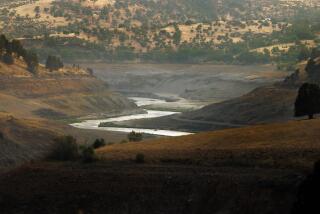BOOK REVIEW / NONFICTION : One Manâs Battle Against Californiaâs Politics of Water : THE RIVER STOPS HERE: How One Manâs Battle to Save His Valley Changed the Fate of California <i> by Ted Simon</i> ; Random House $23, 400 pages
The story of why the Dos Rios Dam was never built is one of the less-celebrated incidents in the vast saga of California water politics, but--to hear Ted Simon tell it in âThe River Stops Hereâ--itâs a tale of epic proportions.
Simon styles the campaign to save the Eel River from the dam-builders of the State Water Project as nothing less than an insurrection by a tiny band of guerrillas against an imperial power. And the unlikely hero of the war on the Dos Rios Dam is a man named Richard Wilson, a wealthy rancher, a registered Republican, and the son of a socially prominent Los Angeles physician.
âIf Richard, and any other allies he might bring to the cause, were to fight this war,â Simon writes, âthey might as well think of themselves as the victims of a land grab by a colonial power, with Los Angeles at the heart of the empire.â
Simon rounds up the usual gang of suspects in describing the manifest destiny of California water policy--the Army Corps of Engineers, the Metropolitan Water District, agribusiness interests, land developers and land speculators.
He explains how a series of disastrous floods in Northern California in the â50s and early â60s helped to create a constituency for the State Water Project--but he points out that flood control was only one of the reasons for damming the wild rivers and sending their water somewhere else.
âDuring the â64 flood more water poured out of the Eel River in eight days than it took to irrigate the entire cotton crop of California for a year,â Simon writes. âLiberated by this new sense of urgency, the engineers emerged from the closet as knights errant, flying the banner of flood control, and once again the area was beset by dam fever.â
The little hamlet of Dos Rios and nearby Round Valley in Mendocino County had long been considered as a site for a dam and a reservoir on the Eel River, but not until 1967 did the Dos Rios Dam project loom as a real threat. The dam would be 700 feet high, the reservoir would be 300 feet deep, and Wilsonâs land would be at the bottom of it.
Everyone, it seems, had an ulterior motive when it came to the Dos Rios Dam. Not only were the thirsty suburbs of Southern California and the farm districts of the San Joaquin Valley interested in the Eel, so were more northerly counties that wanted the water for agriculture, tourism and subdevelopment.
Even within Round Valley, the locals were motivated by their own self-interest--one embittered householder, for example, favored the dam because her home in Round Valley was next to a lumber mill and she would have been happy to take the money and run.
But, as Simon tells it, Richard Wilson was unsullied by such mean motives.
âEnvisioning the valley ravaged by bulldozers, an infernal scene adrift with fire, smoke and ash, it was not even so much the loss of the houses and barns but the fate of the trees that haunted him,â Simon writes. âHe simply could not bear the thought of those trees going down. It went beyond self-interest, beyond property and ambition, to more elemental and selfless emotions. It was as far as sacrilege.â
So Wilson went to war against the Dos Rios Dam, and he literally invented himself as a one-man-band of environmental activism. He signed up a press agent; he lobbied the local board of supervisors and the state legislature; he courted the Native American leadership of a nearby reservation, and, in the end, his efforts were instrumental in the passage of Californiaâs Wild and Scenic Rivers Act.
âI stopped them from taking all our rivers,â Wilson declares. âWhat more do you want?â
Now and then, as he describes Wilsonâs war on the Dos Rios project, Simon pauses to invoke the Wilson family history and reprise some of the now-legendary moments in California water politics.
As he follows Wilson through the political labyrinth of the campaign against the Dos Rios Dam, Simon almost inadvertently raises the very hardest questions of environmental politics in his story of the skirmish over a single dam.
What is the proper balance between economic development and environmental preservation? How do we weigh the value of preserving the natural beauty of a backwater community against the value of slaking the thirst of the nationâs most populous state? Is it ever OK to dam a wild river and flood a valley? And, if so, whose river and whose valley?
As a âjournalist and farmerâ--and a self-described âtrue friendâ of Wilson--Simon seems to take it for granted that we have enough dams in California, and anyone who prevents the building of another one is a hero. He may be right, especially in the case of the Eel, but the larger questions go unanswered in âThe River Stops Here.â
More to Read
Sign up for our Book Club newsletter
Get the latest news, events and more from the Los Angeles Times Book Club, and help us get L.A. reading and talking.
You may occasionally receive promotional content from the Los Angeles Times.








